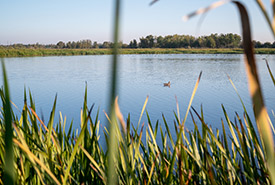OECMs are one of the keys to saving biodiversity

Wetland (Photo by NCC)
The conservation world is no stranger to acronyms. From global events like the 15th meeting of the Conference of the Parties (or COP15), to how we reference areas where Indigenous-led conservation is at the forefront (Indigenous Protected and Conserved Areas/IPCAs), big conservation ideas are often compressed into small nomenclature.
Now let me introduce you to another acronym, one that will be on the minds, lips and filling up rooms across COP15 in Montreal: OECMs.
OECMs, or other effective area-based conservation measures, are lands and waters that are managed for a primary purpose other than the conservation of nature, but, through that management, still provide the same biodiversity conservation benefit as a protected area. This could include areas such as watershed management areas or native rangelands or areas used for biological research. Recognizing and supporting the conservation benefits of these lands where people live, work and play is a way to feed two birds with one scone (in the case of an agricultural area – almost literally!)
“Alongside protected areas, OECMs support a representative and well-connected conservation network,” says Megan Lafferty, manager of land protection measures at the Nature Conservancy of Canada (NCC). “OECMs are an opportunity for collaboration to support resilient landscapes for people and nature.”
They help to bring together people, communities and nature. This exact sentiment is mirrored in global conservation gatherings like COP15: coming together to create solutions that target the twin crises of climate change and biodiversity loss.
As I immerse myself as one of NCC’s youth delegates in sessions covering all the conservation acronyms on offer at COP15, I have a special interest in OECMs as a potential solution to addressing the twin crises of biodiversity loss and climate change.
To complement the conversations at COP15, NCC will be hosting a gathering for conference delegates to discuss how the rapid loss of biodiversity is driving the need for innovative solutions in our approach to safeguarding nature, our way of life and our economy. We will bring together global experts to shine a light on how OECMs are an equitable tool for effectively conserving nature.
Beyond the walls of COP15, NCC has the experience and knowledge to accelerate OECM recognition in Canada. Through strong, nation-wide relationships and creative problem solving, diverse groups (such as governments, industries and communities) can collaborate to achieve multisectoral goals through OECM recognition. NCC believes that everyone has a role to play in supporting biodiversity conservation and OECMs are an important part of Canada’s larger conservation picture..
As someone who is passionate about innovative and collaborative ways to protect the land, I see OECMs are a conservation solution that brings together people while benefiting biodiversity. OECMs are one of the collaborative solutions needed if we are going to meet Canada’s ambitious biodiversity goals, such as 30 x 30, to ensure a future for all wild spaces across Canada and globally.


